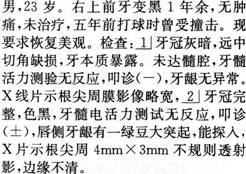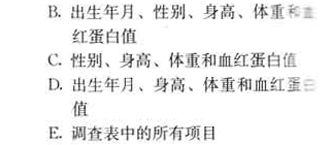共用题干 第一篇Immune FunctionsThe immune system is equal in complexity to the combined intricacies of the brain and nervous system. The success of the immune system in defending the body relies on a dynamic regulatory communication net- work consisting of milli
题目
共用题干
第一篇
Immune Functions
The immune system is equal in complexity to the combined intricacies of the brain and nervous system.
The success of the immune system in defending the body relies on a dynamic regulatory communication net-
work consisting of millions and millions of cells.Organized into sets and subsets,these cells pass information
back and forth like clouds of bees flying around a hive(蜂巢).The result is a sensitive system of checks and
balances that produces an immune response that is prompt,appropriate,effective,and self-limiting.
At the heart of the immune system is the ability to distinguish between self and nonself. When immune
defenders encounter cells or organisms carrying foreign or nonself molecules,the immune troops move quickly
to eliminate the intruders(人侵者).Virtually every body cell carries distinctive molecules that identify it as
self. The body's immune defenses do not normally attack tissues that carry a self-marker. Rather,immune
cells and other body cells coexist peaceably in a state known as self-tolerance.When a normally functioning
immune system attacks a nonself molecule,the system has the ability to"remember"the specifics of the
foreign body.Upon subsequent encounters with the same species of molecules,the immune system reacts
accordingly. With the possible exception of antibodies(抗体)passed during lactation(授乳期), this so
called immune system memory is not inherited.Despite the occurrence of a virus in your family,your immune
system must"learn"from experience with the many millions of distinctive nonseif molecules in the sea of
microbes(微生物)in which we live. Learning entails producing the appropriate molecules and cells to match
up with and counteract each nonseif invader.
Any substance capable of triggering an immune response is called an antigen(抗原).Antigens are not
to be confused with illergens(过敏原),which are most often harmless substances that provoke the immune
system to set off the inappropriate and harmful response known as allergy.An antigen can be a virus,a bacte-
rium,or even a portion or product of one of these organisms.Tissues or cells from another individual also act
as antigens,because the immune system recognizes transplanted tissues as foreign,it rejects them.The body
will even reject nourishing proteins unless they are first broken down by the digestive system into their
primary,nonantigenic building blocks.An antigen announces its foreignness by means of intricate and charac-
teristic shapes called epitopes(抗原表位), which protrude(突出)from its surface. Most antigens , even the
simplest microbes,carry several different kinds of epitopes on their surface;some may even carry several
hundreds.Some epitopes will be more effective than others at stimulating an immune response.Only in abnormal
situations does the immune system wrongly identify self as nonself and execute a misdirected immune attack.
第一篇
Immune Functions
The immune system is equal in complexity to the combined intricacies of the brain and nervous system.
The success of the immune system in defending the body relies on a dynamic regulatory communication net-
work consisting of millions and millions of cells.Organized into sets and subsets,these cells pass information
back and forth like clouds of bees flying around a hive(蜂巢).The result is a sensitive system of checks and
balances that produces an immune response that is prompt,appropriate,effective,and self-limiting.
At the heart of the immune system is the ability to distinguish between self and nonself. When immune
defenders encounter cells or organisms carrying foreign or nonself molecules,the immune troops move quickly
to eliminate the intruders(人侵者).Virtually every body cell carries distinctive molecules that identify it as
self. The body's immune defenses do not normally attack tissues that carry a self-marker. Rather,immune
cells and other body cells coexist peaceably in a state known as self-tolerance.When a normally functioning
immune system attacks a nonself molecule,the system has the ability to"remember"the specifics of the
foreign body.Upon subsequent encounters with the same species of molecules,the immune system reacts
accordingly. With the possible exception of antibodies(抗体)passed during lactation(授乳期), this so
called immune system memory is not inherited.Despite the occurrence of a virus in your family,your immune
system must"learn"from experience with the many millions of distinctive nonseif molecules in the sea of
microbes(微生物)in which we live. Learning entails producing the appropriate molecules and cells to match
up with and counteract each nonseif invader.
Any substance capable of triggering an immune response is called an antigen(抗原).Antigens are not
to be confused with illergens(过敏原),which are most often harmless substances that provoke the immune
system to set off the inappropriate and harmful response known as allergy.An antigen can be a virus,a bacte-
rium,or even a portion or product of one of these organisms.Tissues or cells from another individual also act
as antigens,because the immune system recognizes transplanted tissues as foreign,it rejects them.The body
will even reject nourishing proteins unless they are first broken down by the digestive system into their
primary,nonantigenic building blocks.An antigen announces its foreignness by means of intricate and charac-
teristic shapes called epitopes(抗原表位), which protrude(突出)from its surface. Most antigens , even the
simplest microbes,carry several different kinds of epitopes on their surface;some may even carry several
hundreds.Some epitopes will be more effective than others at stimulating an immune response.Only in abnormal
situations does the immune system wrongly identify self as nonself and execute a misdirected immune attack.
Which of the following statements is true?
A:Allergens are usually harmful substances.
B:Antigens can trigger an immune response.
C:People with antigens do not suffer from obvious responses.
D:There is no difference between an antigen and an allergen.
A:Allergens are usually harmful substances.
B:Antigens can trigger an immune response.
C:People with antigens do not suffer from obvious responses.
D:There is no difference between an antigen and an allergen.
参考答案和解析
答案:B
解析:
由第一段第三句中的“like clouds of bees flying around a hive”可知选B。
由文章第二段第五句可知答案为A。
由文章最后一段中的“An antigen announces its foreignness by …characteristic shapes …" 可知选C。
由文章最后一段第一句可知,能引起免疫反应的物质叫抗原,即抗原能引起免疫反应, 故选B
由文章第二段第一句“At the heart of the immune system...”可知选D。 heart相当 于basic。
由文章第二段第五句可知答案为A。
由文章最后一段中的“An antigen announces its foreignness by …characteristic shapes …" 可知选C。
由文章最后一段第一句可知,能引起免疫反应的物质叫抗原,即抗原能引起免疫反应, 故选B
由文章第二段第一句“At the heart of the immune system...”可知选D。 heart相当 于basic。
如果没有搜索结果,请直接 联系老师 获取答案。
相似问题和答案
第1题:
下列题共用题干,回答 152~153 题。

第 152 题

正确答案:B
第2题:
题共用题干
 正确的诊断是
正确的诊断是
 查看材料
查看材料
正确答案:C
暂无解析,请参考用户分享笔记
暂无解析,请参考用户分享笔记
第3题:
(142-143题共用题干)
第142题:


正确答案:C
